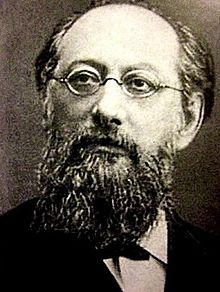Mark Natanson
Mark Natanson | |
|---|---|
 | |
| Born | Mark Andreyevich Natanson 6 January 1851 |
| Died | 29 July 1919 (aged 68) Berne, Switzerland |
| Occupation(s) | Revolutionary, political activist |
Mark Andreyevich Natanson (Template:Lang-ru; Party name: Bobrov) (25 December 1850 (N.S. 6 January 1851) - 29 July 1919) was a Russian-Jewish revolutionary and one of the founders of the Circle of Tchaikovsky, Land and Liberty, and the Socialist-Revolutionary Party. In 1917, he was a leader of the Left Socialist-Revolutionaries, supporting the Bolsheviks in the October Revolution. He was the uncle of Alexander Berkman.
Biography
Early years
Mark Natanson was born in 1850 in Švenčionys, Lithuania to a wealthy Jewish family. He studied in St Petersburg at the Medical and Surgical Academy (1868–71) and at the Institute of Agriculture (1871). During this time, he became involved in radical student politics. He opposed the 'nihilistic' tendency of Sergei Nechaev. Natanson participated in founding the vand the populist (Narodnik) organisation 'Land and Liberty' and helped organise some of the first socialist groups among the small industrial working class in Western Russia.
Natanson also took part in demonstrations, notably the Kazan demonstration in St Petersburg in 1876. After 'Land and Liberty' split, Natanson joined 'The People's Will' (Narodnaya Volya). That group favoured agitation among urban workers and intellectuals over propaganda among the peasants (a tactic adopted by the other offshoot of 'Land and Liberty', the 'Black Repartition' group). Narodnaya Volya also endorsed political terrorism as a tactic and in 1881 assassinated Tsar Aleksandr II.
Natanson was not directly involved in any terrorist act, but, in 1877 he was arrested and banished to Siberia until 1889.[1]
People's Rights Party
After his release he returned to European Russia and became active in Saratov, where in 1893 he founded the party People's Rights Party (Partiia Narodnogo Prava).[1] Historian Shmuel Galai has argued that "for the first time in the annals of Russian parties, it declared organized public opinion to be the main weapon in the struggle against autocracy," in contradistinction to peasant revolt, general strike, or terror.[2]
The People's Rights Party proved to be a short-lived venture, as in 1894, Natanson was arrested again and banished to eastern Siberia for ten years.[1] Natanson remained an active revolutionary even in Siberian exile, maintaining the party treasury and coordinating various organisational tasks.[1]
In 1904, after his release, Natanson went into exile in Switzerland and there became involved in the Socialist-Revolutionary Party (PSR), which united a variety of populist and revolutionary organisations.
The tactical position adopted by the PSR represented a compromise between the rural agitation favoured by South Russian and Ukrainian populists, the factory organisation favoured by 'The People's Right' and the terrorist tactic embraced by the remnants of 'The People's Will' and some of the revolutionary groups of Moscow and St Petersburg. During the abortive Russian revolution of 1905–1907, Natanson returned to Russia and served on the central committee of the PSR.
After the revolution was put down, Natanson returned to exile in Switzerland.
Years of exile
When the First World War broke out in 1914, the PSR, like most other European socialist parties, split into those who supported a war of 'national defence' ('Defencists') and those who opposed the war ('Internationalists'). Natanson sided with the 'Internationalists' and attended the international socialist peace conferences such as the Zimmerwald Conference and one at Kienthal in Switzerland, signing the conference's manifestoes on behalf of the SR Internationalists.[1]
Natanson returned to Russia in 1917 where he was active in the administration of the PSR.
Founder of the Left SRs
When the February Revolution occurred in Russia in 1917, Natanson returned to Russia and became one of the most prominent leaders of the left wing of the PSR, which became increasingly disenchanted with the Provisional Government and with Alexander Kerensky. The left wing SRs eventually broke away from the PSR and formed a separate party, the Party of Left Socialist Revolutionaries. Natanson and the Left SRs supported the Bolshevik Revolution in October 1917 and briefly entered the Soviet government. However, they rejected the Soviet-German peace treaty of Brest-Litovsk (later superseded by the Versailles treaty), which imposed onerous terms on Russia in exchange for a separate peace with Russia.
The Left SRs exited the Soviet government in protest, and some now took up arms against the Bolsheviks. Natanson opposed this course, fearing that a defeat of the Soviet government would spell the end of the revolution and usher in a counter-revolution. He founded the party of Revolutionary Communists, which supported the Bolsheviks and eventually merged with the Communist Party of the USSR. Natanson was a member of the Presidium of the All-Russian Central Executive Committee. However, Natanson's opposition to the anti-Bolshevik uprising of the Left SRs did not imply whole-hearted acceptance of the Bolsheviks' policies. In particular, he objected to Lenin's decision to ban all other political parties in the Soviet Union.
Death and legacy
In 1919, Natanson once again returned to Switzerland and died there.
Footnotes
Further reading
- The Great Soviet Encyclopedia, 3rd Edition, Moscow, 1970–1979.
- Aptekman, O. V. “Dve dorogie teni: Iz vospominanii o G. V. Plekhanove i M. A. Natansone kak semidesiatnikakh.” Byloe, 1921, no. 16.
- Figner, V. N. “M. A. Natanson.” Poln. sobr. soch. vol. 5. Moscow, 1932.
- Itenberg, B. S. Dvizhenie revoliutsionnogo narodnichestva. Moscow, 1965.
